ISSN ONLINE(2319-8753)PRINT(2347-6710)
ISSN ONLINE(2319-8753)PRINT(2347-6710)
K. Latha ,R. Kamalitta
|
| Related article at Pubmed, Scholar Google |
Visit for more related articles at International Journal of Innovative Research in Science, Engineering and Technology
Latent Fingerprint Analysis is a tremendous process in forensic. Fingerprint authenticates a person who is unique. Latent is invisible obtained by inadvertently touching the objects or handled by a person at crime scenes and it contains small area, large non-linear distortions. Due to this improper recognition, automatic latent to full fingerprint matching is extremely difficult. Full-to-full and latent-to-rolled fingerprint matching algorithms published in literature they do not attain an accurate matching. Matching of full fingerprint (which is fusion of rolled with plain) to latent fingerprint is introduced in this paper. Latent fingerprint matching with Hough transform includes minutiae and orientation field for fingerprint identification. This paper proposes a new fingerprint matching algorithm which includes two more parameters such as quality map and similarity measure that provides better accuracy.
Keywords |
| Latent, Hough Transform, matching, minutiae, quality map |
I.INTRODUCTION |
| Biometrics is the technology for measuring and analyzing biological data. Information technology measuring and analyzing human body characteristics like DNA, fingerprints, irises, voice patterns and facial patterns for authentication purposes.A fingerprint is used to authenticate a correct person. Biometrics is applied in business process to secure physical characteristics from internal and external threats in networks. All over the world businesses utilize information as a resource in operational activities. Protecting the information is an important concept in biometric technologies. Fingerprint provides high secure identification and personal verification solutions. |
| Fingerprint recognition systems are used in defense to identifythecrooks.Sensors and matching algorithms are the advanced concepts in biometric. These concepts are very useful in numerous civilian and government establishments. Fingerprint is used in the network access, sign-on restrictions, data protection, wireless remote access limitations, transaction security and web security. |
| A fingerprint is an impression left by the friction ridges of a human finger. The fingerprints are the traces of an impression from the friction ridges of any part of a human or animals. A print from the foot is also the impression of friction ridges. A friction ridge is any portion of the epidermis on the fingers, toes and the palm of the hand. Fingerprint images in Automatic Fingerprint Identification Systems (AFIS) can be classified into three categories rolled, plain or flat and latent. Three types of fingerprint images present in the same finger. Rolled fingerprint images are obtained by rolling a finger from one side to the other that is nail-to-nail in order to capture all the ridges of a finger. Plain fingerprints are which the finger is pressed down on a flat surface but not rolled. Rolled and plain impressions are obtained either by scanning the inked impression on paper or by directly using Live scan devices. |
| Latent fingerprints are lifted from surfaces of objects that are unintentionally touched or handled by a person through a variety of means ranging from simply photographing the print to more complex dusting or chemical processing. Latent fingerprint contains small area, unclear ridge structure, complex background and strong distortion.Latent fingerprints have the worst image quality among the three types of fingerprints. It is the matching of a latent fingerprint against a database of rolled/plain fingerprints is an important concept in crime scenes to identify criminals. |
| Fingerprint examiners, marking manually the finger print region in the latent image or the region of interest (ROI) and singular points. ROI is a closed region that is bounded at the outermost trim of the latent. Only the fingerprint features in the ROI are regarded as valid. Singularities observed in almost all the fingerprints fall into one of the following categories: (i) no singularity present in arch type of fingerprints, (ii) one core and one delta present in Loop and tented arch type, and (iii) two cores and two deltas present in whorl and twin loop type. All fingerprint images does not contain all singular points. For example, plain impression tends to capture only the central area of a finger. Marking singular points using the following convention, based on central area: |
| 1. If the latent does not contain any singularity, no singular points are marked. Even though a latent fingerprint may in fact come from a finger with singularity, the latent will be treated as plain arch, the simplest fingerprint pattern. |
| 2. If the latent contains singular points, cores and deltas should be marked in pairs. For example, the latent fingerprint has one core and one delta in ROI. These singular points are called real singular points since they are present in the ROI. |
| When the numbers of core and delta are not equal, the missing singular points are marked with the best guess. These are called virtual singular points since they are not observable in the ROI. For example, the latent contains only two real cores and the two virtual deltas are also marked with the best guess. Detecting the reference point first and extracting the region, then filtered the image with a bank of Gabor filters with different orientations. The filtered images are discretely coded as the feature, and combined with the minutiae for final decision. This method is used for global orientation information. To avoid its sensitivity detect the reference points. Entire filtered images are called the ridge feature map. All of these concepts need large storage for saving the additional features in the fingerprint template. |
II.RELATED WORK |
| Yang and Zhou proposed an orientation field which describes the global structure of fingerprints and it provides peculiar information other than commonlyused minutiae points. Many methods are used for explicit incorporating information into fingerprint matching stage because of occurring difficulty of saving the orientation fields in feature template. This paper suggests the matching combining the concepts of matchers based on orientation field with minutiae.Widespread experimental results explain about combining local and global discriminative information can merely improve the performance [9]. The feature extraction and matching procedures can be done in about 0.30 seconds. The global orientation field gives benefits to the alignment of the fingerprints which are either incomplete or poor-qualified. Fingerprint alignment method with the minutiae and the orientation field taking much more time but it is an effective for latents. |
| At the period of 2008 Feng discussed minutiaebased fingerprint matching algorithm solve two problems, they are correspondence and similarity computation. Each Minutia is assigned for two descriptors such as texturebased and minutiae-based descriptors, and uses an alignment-based greedy matching algorithm to establish the correspondences between minutiae. Similarity is computed by extracting feature vector from the matching resultand convertsit into a matching score using support vector classifier.The matching algorithm can be improved among two directions. The first direction is to improve the accuracy by designing more complex matching strategy. The second direction is to speed up the algorithm. |
| Feng and jain proposed different fusion techniques [6]. The most of the fusion approaches using plain fingerprints to improve the identification performance. Among many fusion levels score and feature level approaches not well compared. Rank level methods were only analyzed. |
| Yoon and Jain enhanced the latent fingerprint through estimation of latent fingerprint in 2011. During analysis of their approach latent fingerprints have been considered as vital evidence for spotting the criminals. Robust orientation field estimation algorithm presents the enhancement of a latent. Short-time Fourier transforms is used to obtain multiple orientation elements in each image block. A hypothesize-and-test paradigm based on randomized method is used to generate a set of orientation fields. The matching performance of a commercial matcher is significantly improved by utilizing the enhanced latent fingers.Latent fingerprint enhancement algorithm could not applicable to ugly and bad images. |
| In 2010 Nagar said, latent fingerprint enhancement algorithm requires manually marked ROI and singular points [3]. Related enhancement algorithm is an orientation field estimation algorithm, which fits orientation field model to estimated orientation field from skeleton yielded by a fingerprint SDK. NIST SD27 latent fingerprint database indicate that by incorporating the proposed enhancement algorithm, the matching accuracy of the COTS matcher was significantly improved. |
| Yang projected Fingerprint Recognition using Minutia Score Matching method (FRMSM) [12]. The Block Filter is used to scan the image at the boundary to preserve the quality of an image and extract the minutiae from the thinned image. FRMSM method is used for matching the minutia points, and it gives better FMR values compared to the existing methods. |
| In 2008 Feng and Jain consider the huge size of fingerprint databases maintained for matching[7]. One-toone matching is impractical and a database filtering technique is necessary to reduce the search space. Testing system by searching 258 latent fingerprints in NIST SD27 against a background database containing 10,258 rolled fingerprints and its corresponding latent fingerprints.The filtering systems not only improve the matching speed by three fold but also improve the rank-1 matching accuracy from 70.9% to 73.3%. |
| Vatsa and Singh discussed the three concepts are (i) a comparative analysis of existing algorithms, (ii) fusion and context switching frameworks to improve the identification performance and (iii) a multi-latent fingerprint database preparation [4].Evaluating the performance of existing feature extraction and matching approaches along with decision fusion using OR rule, PLR match score fusion, and SVM-based context switching algorithms [10] is a critical one. Latent to latent fingerprint is an important research problem that requires comprehensive research, though context switching is a good option to achieve better accuracy with lesser time complexity, both image quality and numbers of minutiae points are not suitable parameters to switch among the classifiers. It is necessary to explore other parameters that could better exploit the sophistication of the context switching framework. |
| In 2011 Feng and Zhou evaluated the performance of many descriptors [8].A good minutia descriptor should be effective and robust in difficult situations which are noise, occlusion and plastic distortion. Minutia descriptors have been classified into three categories: image-based, texture-based, and minutiabased. Image based descriptors is used to find the minutia is based on Euclidean distance and processed image. |
| Fingerprint normalization, enhancement and binarization are used to compute variations in brightness, contrast and ridge thickness. Texture based descriptors computethe local ridge orientation and ridge frequency information. |
| Minutia based descriptors is classified into two types: nearest neighbor based and fixed radius based. Nearest neighbor based representation is used to define eight dimensional feature vectors. Different descriptors are evaluated according to local matching accuracy for four types of fingerprint pairs: good quality, poor quality, small common region and large plastic distortion. The texture based descriptor and Minutia based descriptor are the two most accurate descriptors. Texture based descriptor ranks first in calculating small common region. |
| JianjiangFeng and Abhishek Nagar discuss about additional features like orientation field and quality map are used in this systems [2]. Implementation is done by using the NIST SD27 latent database indicate that the introduction of orientation field and quality map to minutiae-based matching leads to good recognition performance despite the difficult nature of the problem. On latent matching approach achieves the rank-20 accuracy of 93.4% in retrieving 258 latent from a background database of 2,258 rolled fingerprints. |
III. LATENT FINGERPRINT MATCHING |
| Analysis of latent fingerprints performed by fusion of fingerprints, marking minutiae, constructing quality map, estimating an orientation field, aligning the fingerprints and measuring the similarity to attain high performance. |
A. Fusion of rolled and plain fingerprints |
| Fusion of plain and rolled fingerprints is a multibiometric technique. A multibiometric system combines the different indications from multiple fingers, multiple sensors, multiple samples and multiple representations at three levels such as score level, rank level and feature level. The feature level fusion method consist the plain and rolled fingerprints of the same finger are matched. Features include a matching score, a set of matchedminutiae, and the spatial transformation between the two images. Let TLP, TLR and TPRindicates the rigid transformation matrices from latent to plain ,latent to rolled and plain to rolled, the representation of transformation is TLPR=TLPxTPR |
| Plain and rolled fingerprints are matched based on those features. If the difference between two rotations is less than Π/8and Euclidean distance between two translations is less than 80 pixels, the two rigid transformationsTLPR and TLR is said to be similar.A rolled fingerprint contains more information which requires for latent matching. For genuine match the spatial transformations among latent, plain and rolled impressions are consistent. |
B. Minutiae markup |
| A minutia is a spurious, if it is close to a background block. Consider minutia is an unreliable, if it forms an opposite pair with other minutia. An opposite pair is a pair of minutiae which are close to each other but have opposite direction. Remaining minutiae are deemed as reliable. The features in a latent fingerprint and a rolled fingerprint, the matching algorithm consists of local and global minutiae matching. The similarity between each minutia of latent fingerprint and each minutia of rolled fingerprint is computed. The basic properties of a minutia are location, angle and type. |
| The similarity between two minutiae is defined as the mean value of the similarity of two types of descriptors such as Orientation based descriptor and minutia based descriptors. A set of fixed sampling points is defined and the local ridge orientation at these sampling points forms the orientation descriptor. These sampling points are located on 4 circles centered at the minutia and distributed equally on each circle. The radii of circles are 27, 45, 63 and 81 and the numbers of sampling points on these circles are10, 16, 22, and 28, respectively. These parameters have been determined. |
| The similarity of two orientation descriptors is computed as the mean value of the similarity of all valid sampling points a sampling point falling in the background region is deemed as invalid.If the number of common valid sampling points is less than 25% of the total number of sampling points, the similarity of two orientation descriptors is set to 0. 2. |
| Neighboring minutiae-based descriptor of a minutia is defined to be a circular region of radius 80 pixels. All minutiae lying in this neighborhood are called the neighboring minutiae. Let p and q be the two minutiae whose similarity is to be computed. For each neighboring minutia pi of p, examine if there is a neighboring minutia of q whose properties pi. If such a minutia exists, pi is defined as a matching minutia; otherwise pi is checked against the minutia reliable. It falls in a background region if the minutia is unreliable, when mapped to the other fingerprint based on the alignment parameters between p and q. |
| Global Minutiae Matching provides similarity of all minutia pairs. A one-to-one correspondence between minutiae is established in the global minutiae matching. Greedy strategy is used to find matching minutia pairs in decreasing order of similarity. |
C.Quality map construction |
| After ridge extraction, a block containing any ridge pixel is labeled as reliable and other blocks as background blocks. After ridge validation, set blocks containing unreliable ridges as background. A ridge with 8 neighbors are called reliable block and the rest of them labeled as an unreliable block. |
D.Orientation Field estimation |
| Orientation field estimation using gradient-based method is very reliable in good quality images. It is too difficult when the image contains noise. A new gradientbased algorithm uses overlapping windows and a voting scheme. The ridge patterns from the four overlapping neighborhoods of the target block are highly correlated to each other. If the window size is small, the ridge lines over the whole site are paralleled and slowly varied. One common type of noise appearing in fingerprint images is the smudges that link parallel ridges together. |
| Smudges are usually caused by dirt and result in poor separation of ridge lines.The presence of dirt is uncorrelated and the random noise follows symmetric distribution with zero mean. The ridge lines have strong directions. The variation of gray intensities along a ridge flow is much slower than that in its perpendicular direction. In a smudged area the anisotropy feature of ridge structures is corrupted by the random noise whose orientation pattern is symmetric distributed over all directions. |
E.Alignment |
| Fingerprint alignment consists of estimating the parameters rotation, translation and scaling. Most similar minutia pair is used as a base for the transformation parameters. The descriptor based hough transform is used align the fingerprints. It takes the input as two sets of minutia Ml and Mr and two sets of local descriptors Ol and Or, one set corresponding to the latent and one to the rolled print. Each set contains a local descriptor for each minutia. Initialize the accumulator array. |
| Compute local minutiae descriptor similarity for every possible minutiae pair using and for all possible minutia pair compute their direction difference if Δθ<maxθ then compute translation parameters (Δx,Δy) and increase the voting for this set of alignment parameters. |
| After finding 10 highest peaks in accumulator, for each peak, compute a rigid transformation between two fingerprints using minutia pairs that contributed to peak and its immediate neighborhood. If the estimated transformation not reliable repeat the voting in peak until reach highest peak. |
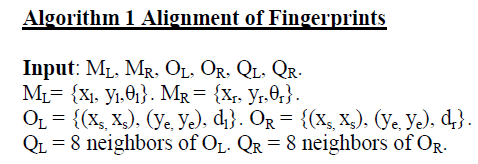 |
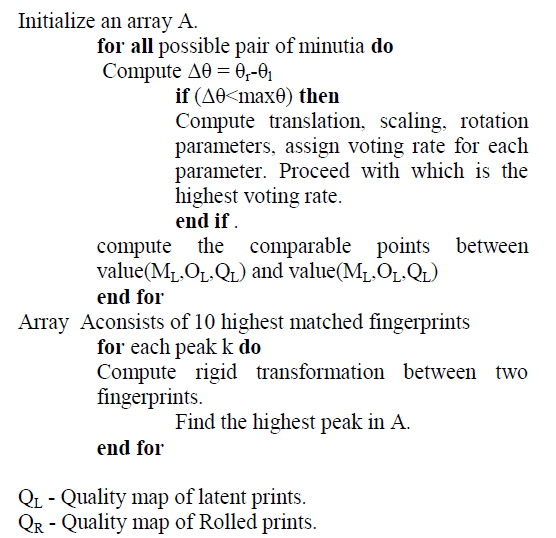 |
F. Measuring similarity |
| After the corresponding minutiae are found, compute a matching score between the latent and the rolled print. Suppose that pairs of matching minutiae between the latent and the rolled print are found. The minutiae matching score between the two fingerprints is given by |
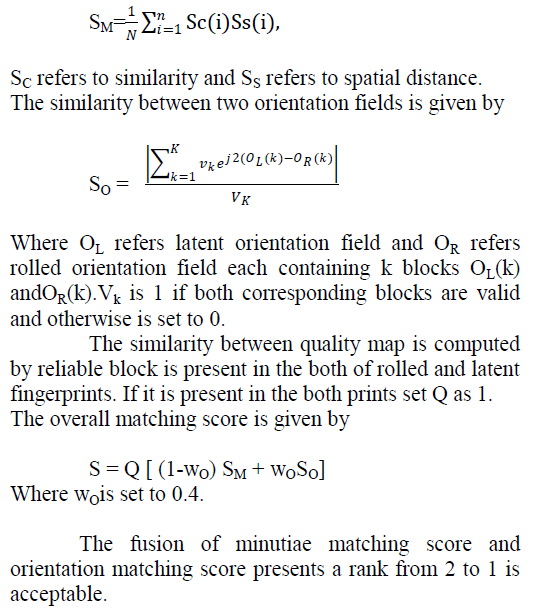 |
IV.EXPERIMENTAL RESULTS |
Database |
| An implementation will conduct on the public domain latent fingerprint database NIST SD27 which contains 258 latent fingerprints and their corresponding rolled fingerprints. Each latent image in this database was assigned one of three quality levels - good, bad, and ugly by latent fingerprint examiners. The quantity of good, bad and ugly latent is 88, 85 and 85, respectively. To make the latent matching problem more realistic and challenging the background database was extended to 27,258 fingerprintsby including 27,000 rolled prints in NIST SD14. |
Performance Evaluation |
| Theaccuracy of latent fingerprint identification enhanced via the fusion of rolled and plain prints. The Cumulative Match Characteristic (CMC) curves are drawn for good, bad and ugly latent with the comparison of minutiae markup, orientation field, quality map and similarity. Recognition of good quality latent images reached high identification rate by extracting all four features. |
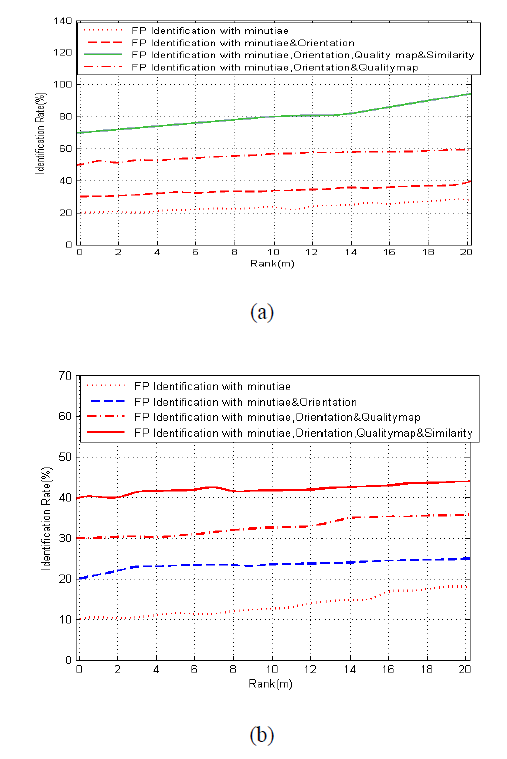 |
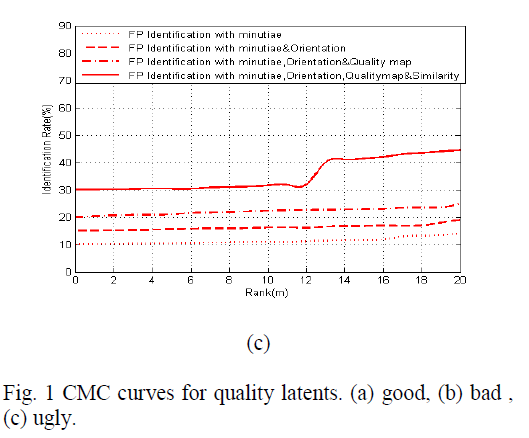 |
V.CONCLUSION |
| During diagnosis of Latent fingerprint, latent and rolled fingerprints are analyzed. Fusion of rolled and plain fingerprints presents better accuracy than direct use of rolled prints.Existing latent fingerprint recognition considered only the two metrics such as minutiae and orientation field. This paper yield good performance by extracting all featuresfrom both full and latent fingerprints which are minutiae, orientation field, quality map and similarity. Overlapping is avoided here. Matching get more accuracy and improvedperformance achieved by avoidance of manual marking minutia for good matching speed. |
References |
|